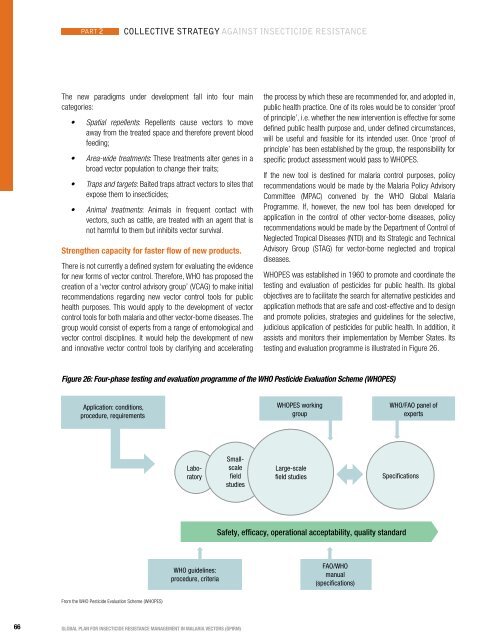Global plan for insecticide resistance management in malaria vectors
Global plan for insecticide resistance management in malaria vectors
Global plan for insecticide resistance management in malaria vectors
- No tags were found...
Create successful ePaper yourself
Turn your PDF publications into a flip-book with our unique Google optimized e-Paper software.
Part 2Collective strategy aga<strong>in</strong>st <strong><strong>in</strong>secticide</strong> <strong>resistance</strong>The new paradigms under development fall <strong>in</strong>to four ma<strong>in</strong>categories:• Spatial repellents: Repellents cause <strong>vectors</strong> to moveaway from the treated space and there<strong>for</strong>e prevent bloodfeed<strong>in</strong>g;• Area-wide treatments: These treatments alter genes <strong>in</strong> abroad vector population to change their traits;• Traps and targets: Baited traps attract <strong>vectors</strong> to sites thatexpose them to <strong><strong>in</strong>secticide</strong>s;• Animal treatments: Animals <strong>in</strong> frequent contact with<strong>vectors</strong>, such as cattle, are treated with an agent that isnot harmful to them but <strong>in</strong>hibits vector survival.Strengthen capacity <strong>for</strong> faster flow of new products.There is not currently a def<strong>in</strong>ed system <strong>for</strong> evaluat<strong>in</strong>g the evidence<strong>for</strong> new <strong>for</strong>ms of vector control. There<strong>for</strong>e, WHO has proposed thecreation of a ‘vector control advisory group’ (VCAG) to make <strong>in</strong>itialrecommendations regard<strong>in</strong>g new vector control tools <strong>for</strong> publichealth purposes. This would apply to the development of vectorcontrol tools <strong>for</strong> both <strong>malaria</strong> and other vector-borne diseases. Thegroup would consist of experts from a range of entomological andvector control discipl<strong>in</strong>es. It would help the development of newand <strong>in</strong>novative vector control tools by clarify<strong>in</strong>g and accelerat<strong>in</strong>gthe process by which these are recommended <strong>for</strong>, and adopted <strong>in</strong>,public health practice. One of its roles would be to consider ‘proofof pr<strong>in</strong>ciple’, i.e. whether the new <strong>in</strong>tervention is effective <strong>for</strong> somedef<strong>in</strong>ed public health purpose and, under def<strong>in</strong>ed circumstances,will be useful and feasible <strong>for</strong> its <strong>in</strong>tended user. Once ‘proof ofpr<strong>in</strong>ciple’ has been established by the group, the responsibility <strong>for</strong>specific product assessment would pass to WHOPES.If the new tool is dest<strong>in</strong>ed <strong>for</strong> <strong>malaria</strong> control purposes, policyrecommendations would be made by the Malaria Policy AdvisoryCommittee (MPAC) convened by the WHO <strong>Global</strong> MalariaProgramme. If, however, the new tool has been developed <strong>for</strong>application <strong>in</strong> the control of other vector-borne diseases, policyrecommendations would be made by the Department of Control ofNeglected Tropical Diseases (NTD) and its Strategic and TechnicalAdvisory Group (STAG) <strong>for</strong> vector-borne neglected and tropicaldiseases.WHOPES was established <strong>in</strong> 1960 to promote and coord<strong>in</strong>ate thetest<strong>in</strong>g and evaluation of pesticides <strong>for</strong> public health. Its globalobjectives are to facilitate the search <strong>for</strong> alternative pesticides andapplication methods that are safe and cost-effective and to designand promote policies, strategies and guidel<strong>in</strong>es <strong>for</strong> the selective,judicious application of pesticides <strong>for</strong> public health. In addition, itassists and monitors their implementation by Member States. Itstest<strong>in</strong>g and evaluation programme is illustrated <strong>in</strong> Figure 26.Figure 26: Four-phase test<strong>in</strong>g and evaluation programme of the WHO Pesticide Evaluation Scheme (WHOPES)Application: conditions,procedure, requirementsWHOPES work<strong>in</strong>ggroupWHO/FAO panel ofexpertsLaboratorySmallscalefieldstudiesLarge-scalefield studiesSpecificationsSafety, efficacy, operational acceptability, quality standardWHO guidel<strong>in</strong>es:procedure, criteriaFAO/WHOmanual(specifications)From the WHO Pesticide Evaluation Scheme (WHOPES)66GLOBAL PLAN FOR INSECTICIDE RESISTANCE MANAGEMENT IN MALARIA VECTORS (GPIRM)
















